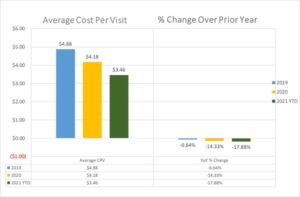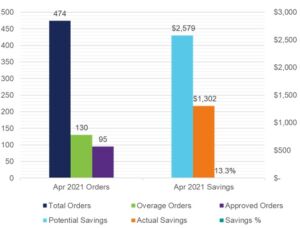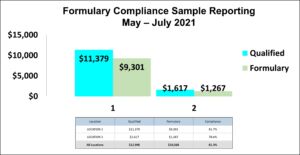Strategies to decrease the pressures of delivering high-level care with fewer financial and staffing resources.
Interviews with Robert Ford, PT, President & CEO, Brockton Visiting Nurse Association; and Larry Havens, Purchasing Manager, UR Medicine Home Care
ABOUT BROCKTON VISITING NURSE ASSOCIATION
Brockton Visiting Nurse Association was established in 1904. Today they serve 32 communities in Southeastern Massachusetts. The Brockton Visiting Nurse Association offers a full range of home health care services, including medical services, management of chronic conditions, and care to meet the needs of every generation, from at-risk infants to those at the end of life.
ABOUT UR MEDICINE HOME CARE
UR Medicine Home Care (URMHC) is a Division of the University of Rochester that provides Home Care Services for the seven counties that surround Rochester, NY. URMHC has approximately 700 employees and 1,200 volunteers. In 2020, URMHC serviced 20,959 patients, and provided 179,920 professional visits. Additionally, URMHC provided 58,741 days of service to hospice patients, and 166,484 hours by paraprofessional staff.
Is your organization facing these 5 key medical supply management challenges?
- Billing complexities
- Controlling costs
- Supply management
- Documentation
- Outcomes and quality
Learn how Bob and Larry’s organizations tackled these challenges to improve medical supply management, reduce costs, and improve outcomes.

Robert Ford

Larry Haven
MEDICAL SUPPLY STANDARDIZATION
How has your supply management program created standardization for Medicare and non-Medicare supply needs? Explain the importance of having a formulary in place.
Robert Ford
Brockton VNA and Hospice (BVNA) works with our supply partner to create an approved list of supplies that we know to be clinically effective and cost effective. We work closely to evaluate each product so we know that the patients will receive the highest quality care as well as we know the product will meet the clinical efficacy needed.
It is important to utilize products that match our clinical operational needs as well as provide effective healing. Through our partnership, we have been able to identify products that allow our clinicians to be confident of their treatment plans. Specifically speaking to wound and ostomy supplies, our clinicians need to trust that the products utilized will match our visit frequency plans.
BVNA utilizes the expertise of our partner’s clinical staff to help us identify the product that will match the needs of our patients and physicians. Coordinating the selection of supplies to create an up-to-date formulary list allows BVNA to have the best products on hand for our clinicians that meet our patient’s needs.
The formulary takes the guess work out of the clinician’s hands when they are evaluating multiple options for treatments. They know that the products on our formulary have been proven to be effective for patient care and will meet the needs of their care plan.
FINANCIAL
How has your medical supply program reduced your cost per episode? How does the program help to forecast supply costs?
Larry Havens
UR Medicine Home Care has weekly tracking of actual supply costs by patient, by clinician, and by product. We have been able to establish the ongoing costs compared to previous periods to determine if our supply program is performing as expected.
More patients with non-traditional Medicare or commercial insurance plans receive home care services today. A medical supply program must benefit all patients not only those under a traditional Medicare episode, states Byram Healthcare.
The graph above is based on data provided by Havens. It shows the results from a pilot that began in 2019, when URMHC trialed a partnership with a medical supply company that offered insurance billing expertise, strong partnerships with health plans, and robust in-network supply coverage for their non-Medicare patients on service. Based on the decrease in URMHC’s Average Cost Per Visit (ACPV) during this 2019 pilot, URMHC then transitioned all their business to this supply partner, realizing significant savings as seen in the decrease in their ACPV from 2019 to 2021 YTD in the graph below.
CLINICAL TEAM SUPPORT
How does utilization management support your clinical teams and protocols?
Robert Ford
Utilization management allows our clinicians to focus on providing optimal clinical care in an efficient manner. The individual clinicians are not required to be up to date on all the products. They can trust that the research has been done and that content experts have provided guidance behind the scenes to identify the best products for a variety of clinical situations.
The challenge in home health and hospice is that clinicians are required to be competent in a variety of conditions. Often, they will see complex medical cases or move from patients with varied conditions. They cannot themselves be experts in all medical conditions. Utilization management allows for the most effective modalities to be utilized and allows for the clinical trust in the process.
OPERATIONAL EFFICIENCIES
Describe the operational efficiencies gained by your supply management program.
Larry Havens
Using our supply partner’s entry software, our agency will once fully implemented, be able to reduce lead times to our patients by one full day. Additionally, there is immediate feedback from our partner’s Customer Service group that reviews each patient supply order to achieve compliance to existing formulary and utilization rules.
An organization’s clinical productivity and patient outcomes can be improved by choosing partners that align with the agency’s overall goals in patient care, states Byram Healthcare. The right supply program can minimize indirect costs related to:
- Excessive use of closet stock.
- Paying for supplies that are covered under the patient’s insurance.
- Use of on-hand supplies or adverse events due to delivery delays.
- Wasted skilled visit because wound care supplies did not arrive.
- Over-utilization of supplies.
- Increased patient co-pays.
- Re-hospitalization.
- Nurse & patient dissatisfaction.
- Poor clinical outcomes
Removing barriers to easy and affordable access to critical supplies, such as wound care supplies, not only provides financial savings to agencies, but it makes it easier for clinicians to provide care and has an overall impact on nurse and patient satisfaction.
NON-MEDICARE AND MANAGED CARE PATIENTS
Explain how your agency provides access to supplies for Medicare and managed care patients. How does your agency manage the billing complexities associated with supplies, especially wound care, for non-traditional Medicare and managed care patients on service with your agency?
Robert Ford
Brockton VNA and Hospice relies on our supply partner for all the billing complexities. That is a major benefit of partnering. BVNA does not worry about the billing issues. Our supply partner has effective rules in place for overseeing the supply order process and works with BVNA to implement appropriate par level ordering, so our clinicians do not over order or end up being out of compliance with what is approved by the individual insurances.
Our supply partner’s ordering processes acts as a stop gap for any ordering out of the appropriate levels and will automatically trigger a review if a clinician goes over the par level normally associated with the patient’s condition.
From a financial oversight position, this allows management to be confident that our clinical team is effectively utilizing supplies in the delivery of patient care.
Larry Havens
Our agency conducted an RFP for supply distribution at the end of 2019. We requested submittals from four major distributors with emphasis on the importance of having contracts established with most of our patient insurance providers. Upfront costs were reasonably the same, however, the major decision criteria was based upon which distributor was the most capable of providing supplies that maximized the use of insurance carriers to offset supply charges to our agency.
Our supply partner provided the best solution. Using their knowledge of best practices, best formulary, and accepted utilization rules, we were able to significantly reduce our annual supply costs by adhering to the parameters established by Medicare and Medicaid. Quarterly Business Reviews (QBR) were implemented to review status and provide guidance for the future based upon actual results achieved. Costs were compared to past quarters and actions taken to maximize future results.
As an example, Medicare B coverage allows for up to 3 foams per week (12 for 30 days). The agency set the same par value and instituted an approval process for overages. By adhering to these parameters for formulary products, savings were achieved monthly as demonstrated in the graph above from a QBR.
Describe the types of reports your organization can generate to analyze orders and have greater control over cost and utilization?
Larry Havens
Our agency maintains an ongoing formulary list that is imbedded in the ordering process so our clinicians know what supplies are approved and how many of each can be provided while maintaining CMS compliance. Our supply partner provides reporting to measure compliance.
Above is a sample of a formulary compliance report provided by Byram Healthcare. This looks at the total cost of products ordered (i.e. wound care) for a 3-month period that are managed and what percent of the agency spend is on formulary products. Formularies offer consistency in clinical care, take the guesswork out of ordering, and provide financial benefits.
Byram adds that access to trended, on-demand and benchmark reporting helps control utilization and drives clinician ordering of the right products to optimize patient care. Quarterly Business Review should be conducted to review metrics such as:
- Average cost per patient, including per wound patient
- Formulary compliance
- Product ranking
- Supply cost per Month by location and product line
- Nurse supply expenditures
- Trended payer mix
- Transit study audits











